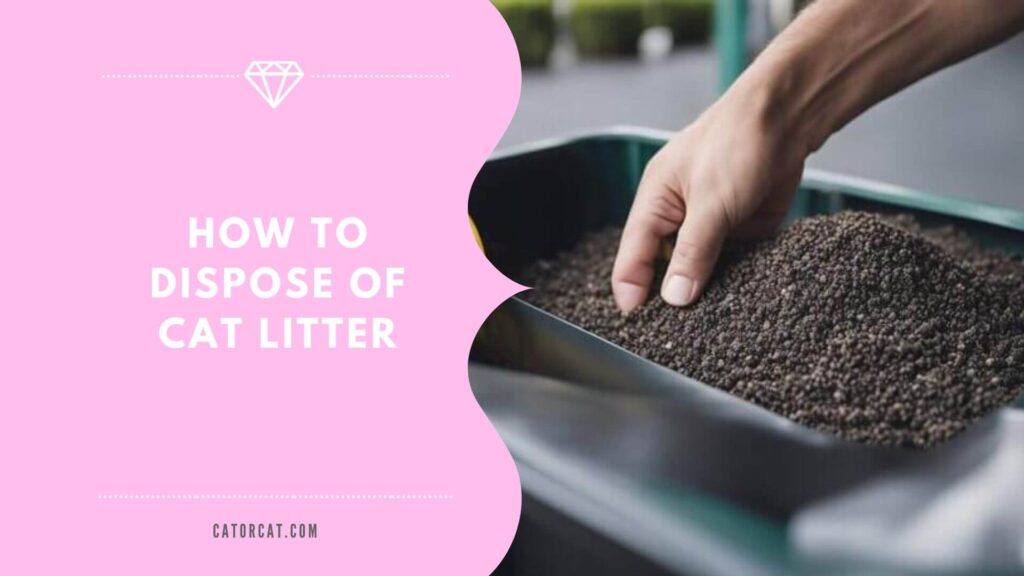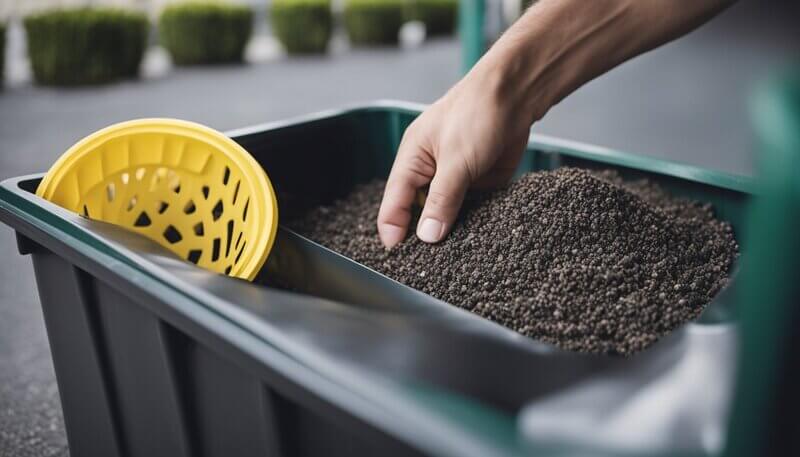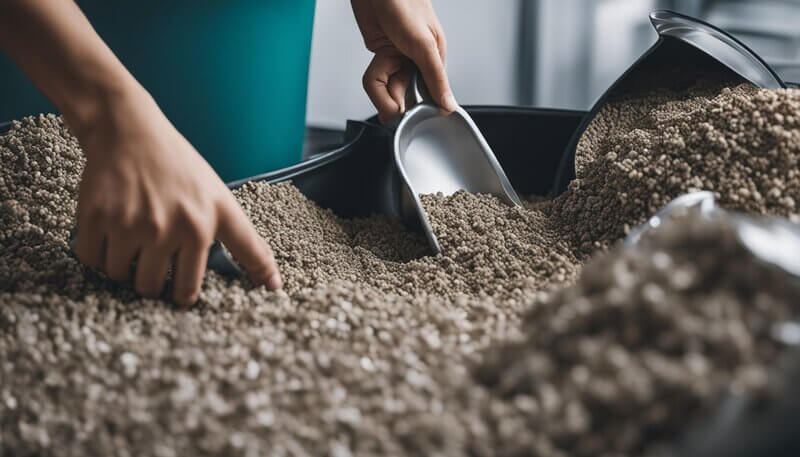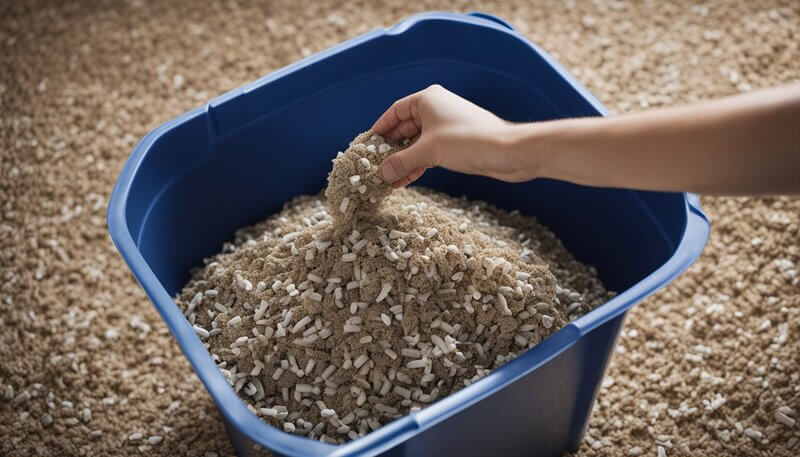
Key Takeaways
- Proper disposal of cat litter involves understanding the type of litter and following the correct methods.
- Biodegradable options offer environmental benefits but require specific disposal conditions.
- Community regulations and health implications are important considerations for disposing of cat litter.
Disposing of cat litter is routine for any cat owner, but it’s more complex than simply tossing it into the trash. The disposal process has implications for the household, the environment, and even legal and health considerations.
Various cat litter is available on the market, each with its own disposal guidelines. From traditional clumping litters to eco-friendly options, knowing the appropriate disposal method is essential. Improper disposal can lead to health risks for humans and pets and potential legal issues.
Review: Kitty Poo club reviews
It is crucial to understand the different types of cat litter and their respective disposal methods.
Biodegradable and compostable litters provide environmentally friendly options but require specific conditions to break down safely.
Meanwhile, traditional cat litter, typically made from clay or silica, is designed to remove waste from the litter box easily but often ends up in landfills.
Residents should consider their community’s waste management regulations, as some areas may restrict discarding used litter.
Furthermore, maintaining good litter box habits is essential for cleanliness and minimizing the health risks associated with cat waste.
Understanding Cat Litter

Choosing the suitable cat litter is essential for your cat’s and home’s health and hygiene.
Types of Cat Litter
- Clay-based Litters: The most common and typically most affordable option, these litters often contain bentonite clay, which clumps together when wet. The clumping action simplifies scooping waste, but it also means that the litter can create dust when poured or disturbed. (Related: Is clay litter bad for cats)
- Biodegradable Litters: Environmental concerns have brought a rise in biodegradable litters composed of materials such as corn, wheat, and pine cobble. They are often dust-free and offer natural odor control, with the added benefit of being compostable in some cases.
- Silica Gel Litters: These consist of silica crystals and are highly absorbent. They can last longer and control odors well, but they can also be more expensive and may cause issues if ingested in large amounts.
Review: Pretty Litter – The World’s Smartest Cat Litter
Health and Safety Concerns for Cats and Humans
- Toxoplasma gondii (T. gondii): This parasite can be present in cat litter and is a concern for pregnant women and immunocompromised individuals.
- It’s crucial to handle litter with care, avoid ingestion, and wash hands thoroughly after cleaning the litter box.
- Dust and Respiratory Issues: Fine dust from clay and silica litters can contribute to respiratory issues in both cats and humans if inhaled over a long period of time.
- Dust-free or low-dust options are important for those with sensitivities.
- Physical Ingestion by Cats: Some cats may ingest litter particles, which can become problematic, especially with clumping litters that contain sodium bentonite. It expands upon contact with moisture and could cause blockages if a significant amount is swallowed.
Proper Disposal Methods

Proper disposal of cat litter is essential to maintaining home hygiene and minimizing environmental impact. This section details daily cleaning procedures, safe methods for disposing of used cat litter, and environmental considerations to keep in mind.
1. Daily Cleaning Procedures
Daily maintenance of the cat litter box is crucial for odor control and hygiene.
Gloves should be worn during cleaning to prevent contamination.
One should use a cat litter scoop to sift through the litter and remove waste, which can then be placed into a plastic bag or garbage bag.
For optimal hygiene, this process should be conducted at least once a day.
2. Disposing of Used Cat Litter
Once collected, cat litter should never be flushed down the toilet, as it can harm the water supply and lead to plumbing issues.
Instead, secure the waste in a biodegradable or brown paper bag and dispose of it in the trash.
For non-biodegradable litter, using a plastic bag and ensuring it’s tightly sealed before placing it in a plastic tub or stainless steel steam pan** is advised to prevent odor and bacterial leakage.
3. Environmental Considerations
When considering the environment, eco-friendly litter, such as those made from grass seed, pine, or other compostable materials, is beneficial.
These litters can sometimes be composted, but verifying if the specific product is safe for this purpose is crucial.
Flushing cat litter is exceptionally discouraged because certain types of litter can clump and block plumbing, and the waste can carry pathogens harmful to marine life.
Products like flushable litter claim to be safe for plumbing, but users must carefully follow guidelines to ensure they do not affect their local water supply.
Moreover, biodegradable bags should be used for disposal to reduce environmental impact further.
Biodegradable and Compostable Litters
Biodegradable and compostable litters offer environmentally friendly options for cat owners. Made from materials such as wood shavings, newspaper, coconut, and compressed paper, they can be broken down naturally and repurposed to benefit the earth.
Composting Cat Litter
Composting cat litter made from biodegradable materials is a sustainable method to manage pet waste.
When composting, it is vital to use only biodegradable litter composed of natural fibers. Traditional clay-based litter do not break down well and can contain harmful chemicals.
To compost cat waste, dedicate a separate compost bin. Pet waste requires different handling due to potential pathogens.
The composting process for cat litter typically takes longer than composting other organic waste, up to two years to be safe for use in non-edible gardens.
Necessary: Avoid using composted cat litter on edible crops due to the risk of transmitting parasites or diseases.
Using Cat Litter in Gardens
In a garden setting, certain types of biodegradable cat litter can be used directly as mulch or incorporated into potting soil after proper composting.
Materials like sawdust and sand, sometimes used as litter, can benefit the soil structure and water retention.
However, composted cat litter should be restricted to flower gardens and non-food-producing areas.
Before applying to garden beds, ensure the litter is fully composted; it should resemble dark, crumbly topsoil free of recognizable waste material.
Remember that litter should not be used in gardens if it contains additives or deodorants.
Review: Best cat litter deodorizer
Alternatives to Traditional Cat Litter

Switching to eco-friendly cat litter options reduces the environmental impact and offers a sustainable way to take care of a pet’s needs. These alternatives are often made from renewable resources and are biodegradable.
Eco-Friendly Litter Choices
Eco-friendly cat litters provide responsible alternatives that are both good for the environment and safe for pets.
Grass seed cat litter is one such option. It is made from naturally absorbent grass, which is lightweight and can be more easily broken down by natural processes than traditional clay litter. It’s also free of silica dust, which benefits the respiratory health of both cats and their owners.
Another sustainable choice is litter made from plant-based options.
These include recycled paper, wood pellets, pine, wheat, corn, or walnut shells.
These highly absorbent materials are often naturally deodorizing and can be composted.
For example, wood pellets are commonly sourced from lumber waste and are absorbent, lower in dust, and provide a natural pine scent to help control odor.
It’s important to note that while these eco-friendly litters are more sustainable, they should still be disposed of properly.
Cat waste should not be composted in gardens as it can contain harmful pathogens. Instead, dedicated pet waste composting services or systems must be considered for proper and safe disposal.
Health Risks and Environmental Impacts
Disposing cat litter improperly can lead to significant health risks, including the spread of toxoplasmosis, while posing environmental threats such as increased methane emissions and damage from strip mining.
Toxoplasmosis Concerns
Toxoplasma gondii is a parasitic organism often found in cat feces. This pathogen can cause toxoplasmosis, a disease that can be particularly dangerous for pregnant women and individuals with weakened immune systems.
T. gondii can persist in the environment and may be spread if cat waste is not disposed of properly.
For example, flushing cat litter can lead to T. gondii entering the wastewater treatment system, where it may not be effectively removed and thus contaminate water.
Environmental Impact of Cat Litter
The production and disposal of cat litter contribute to environmental issues.
Conventional cat litter is often made through strip mining, which leads to habitat destruction and water pollution.
After use, most cat litter ends up in plastic bags in landfills, where it can take centuries to break down while releasing methane emissions, a potent greenhouse gas.
Additionally, tossing cat litter in trash bins ignores the possibility of using biodegradable materials or more sustainable disposal practices like composting.
Pet owners must develop a routine to handle cat waste that emphasizes using biodegradable alternatives and proper disposal methods to mitigate these impacts.
Legal and Community Considerations
When considering the disposal of cat litter, one must be aware of local regulations and the impact on the community. The appropriate disposal methods can vary depending on the location, the type of litter used, and the presence of waste management protocols that address environmental protection.
Disposal Regulations and Best Practices
Local laws often dictate the proper way to dispose of cat litter. For instance, some communities might prohibit the disposal of cat feces in municipal waste due to health concerns, including the risk of toxoplasmosis.
One should consult their local waste management authority to confirm the legal disposal method in their area.
In addition to legal requirements, there are best practices to follow when disposing of cat litter.
Litter boxes should be cleaned regularly, and the used litter should be placed in a biodegradable or compostable bag before being disposed of in the trash.
Related: How often to change cat litter
Flushing cat litter down the toilet is typically frowned upon, especially for those with septic systems, as it can cause blockages and environmental harm. This is due to the potential presence of harmful organisms and preservatives in the litter.
It is also essential for individuals to understand the specific needs of different types of litter.
For example, clumping litter should never be flushed as it can clump and solidify in plumbing systems, causing significant damage.
Non-clumping litter, while less likely to cause blockages, may still contain chemicals or materials unsuitable for sewage or septic systems.
Community guidelines may also encourage the use of practices to minimize odors and maintain hygiene.
The use of specially designed litter disposal systems, which effectively contain and neutralize odors, supports a more harmonious living environment for all.
Cat Litter and Household Habits
Proper cat litter disposal is crucial for maintaining a clean household and practicing environmental responsibility. Safe and eco-friendly habits can be seamlessly integrated into daily routines, ensuring that cat litter management becomes a thoughtful part of domestic life.
Cultivating Sustainable Practices
Choosing the Right Disposal Bags: Households should opt for biodegradable bags to minimize plastic waste when disposing of cat litter. These bags break down more quickly in landfills, significantly reducing the environmental impact compared to traditional plastic bags.
Minimizing Odors and Maintaining Hygiene: Utilizing a small amount of baking soda or pet-safe odor-neutralizing powders before bagging the litter can help control odors without harming the environment.
Households should also consistently use soap and water to wash their hands after handling pet waste, which maintains cleanliness and reduces the spread of germs.
Reducing Litter Waste: Instead of fully replacing litter, individuals can extend the life of their cat litter by sifting out only waste with a scoop and topping up with fresh litter as needed. This habit reduces the amount of litter used and the frequency of disposal.
Using Masks During Cleaning: For those with sensitivities or allergies, wearing a mask while cleaning the litter box can prevent inhalation of dust and potential allergens.
This practice also applies to individuals who might be immunocompromised or pregnant, where extra caution is necessary.
Frequently Asked Questions
This section addresses common inquiries regarding the disposal of cat litter and offers clear, environmentally conscious guidance for pet owners.
1. What is the best method to dispose of cat litter in an apartment setting?
In an apartment, it is generally advised to seal used cat litter in a bag and bin it, using bags that control odor and leaks. Litter should then be placed in a designated waste bin outside.
2. How can one dispose of cat litter in an environmentally friendly manner?
Environmentally-friendly cat litter disposal includes using biodegradable bags or looking for litter made from natural materials that could be composted under certain conditions.
3. Are there any biodegradable alternatives for cat litter bags, and how should they be used?
Yes, there are biodegradable alternatives to regular plastic bags. When using biodegradable bags for cat litter disposal, one should ensure the bags are correctly sealed to prevent leaks and odors.
4. What are the appropriate steps to dispose of a cat litter box, including the litter?
To dispose of a cat litter box, first remove and discard the litter. Thoroughly clean the box and then consider repurposing, recycling, or placing it in the trash as a last resort.
5. When living in the country, what are the recommended practices for cat litter disposal?
Country living often allows for different disposal methods, such as burying the litter (if it is biodegradable) in a designated location away from vegetable gardens and water sources. Otherwise, regular waste management practices should be followed.
6. Is it necessary to discard all the cat litter at once, and what are the guidelines?
It is not necessary to discard all cat litter at once. It’s recommended that waste clumps be removed regularly. Also, fresh litter should be added to maintain cleanliness, replacing all litter periodically according to the manufacturer’s instructions.
